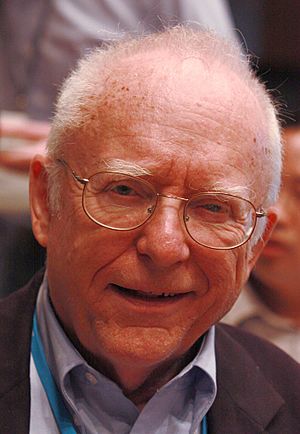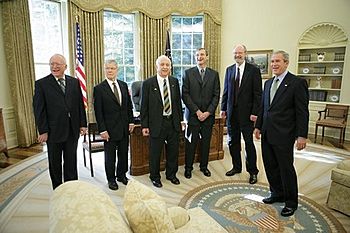John L. Hall facts for kids
Quick facts for kids
John Lewis Hall
|
|
|---|---|

Hall at the 2012 Lindau Nobel Laureate Meeting
|
|
| Born | August 21, 1934 |
| Nationality | American |
| Alma mater | Carnegie Institute of Technology |
| Known for | Optical frequency comb Optical clock Pound–Drever–Hall technique |
| Awards | Department of Commerce Gold Medal (1969) Nobel Prize in Physics (2005) |
| Scientific career | |
| Fields | Physics |
| Institutions | University of Colorado Boulder, JILA, NIST |
| Thesis | Electron spin resonance of interstitial hydrogen atoms in calcium-fluoride (1962) |
| Doctoral students | Jun Ye |
John Lewis "Jan" Hall (born August 21, 1934) is an American physicist who won a Nobel Prize for his amazing work with lasers. He helped invent new ways to measure light with incredible precision. This work has been super important for developing things like ultra-accurate clocks and GPS technology.
In 2005, he shared the Nobel Prize in Physics with Theodor W. Hänsch and Roy Glauber. They were recognized for their major contributions to the field of precision spectroscopy, which is the science of studying how light and matter interact.
Contents
Early Life and Education
John Hall was born in Denver, Colorado. He was very interested in science from a young age. He went to the Carnegie Institute of Technology for college, where he earned three degrees:
- A Bachelor of Science (B.S.) degree in 1956
- A Master of Science (M.S.) degree in 1958
- A Ph.D. (a doctor's degree in research) in 1961
After finishing his Ph.D., he began working at the National Institute of Standards and Technology (NIST). This is a U.S. government agency that deals with measurement science. He worked there from 1962 until he retired in 2004. He also taught physics at the University of Colorado Boulder starting in 1967.
Scientific Career and Discoveries
Dr. Hall spent most of his career at JILA, a research center run by both the University of Colorado Boulder and NIST. There, he did groundbreaking research with lasers.
The Optical Frequency Comb
One of his most famous achievements was helping to develop the optical frequency comb technique. Imagine trying to measure the color, or frequency, of a laser beam. It's like trying to measure a tiny object with a ruler that has no markings.
Hall and his colleague Theodor W. Hänsch created a special tool using lasers. This tool, the "frequency comb," acts like a super-precise ruler for light. It creates millions of laser frequencies that are all perfectly spaced, like the teeth of a comb. This allows scientists to measure the frequency of any light source with amazing accuracy.
This invention was a huge leap forward. It is used to build extremely precise optical clocks, which are far more accurate than the atomic clocks used for GPS. It also helps in many other areas of science and technology.
Advocating for Science
Dr. Hall believes that science is very important for society. In 2008, he and 19 other American Nobel Prize winners signed a letter to President George W. Bush. They asked the government to provide more funding for basic science research.
He also showed his support for protecting the environment. In 2015, he signed the Mainau Declaration 2015 on Climate Change. This was a statement signed by 76 Nobel laureates urging world leaders to take action on climate change.
Awards and Recognition
For his incredible work, John Hall has received many awards. The most famous is the 2005 Nobel Prize in Physics.
Some of his other major honors include:
- The Department of Commerce Gold Medal in 1969, 1974, and 2002
- The Charles Hard Townes Award in 1984
- The Frederic Ives Medal in 1991
- The Max Born Award in 2002
- Membership in the French Légion d'Honneur in 2004
These awards recognize his role as a pioneer in laser science and his important contributions to physics.
See also
 In Spanish: John L. Hall para niños
In Spanish: John L. Hall para niños


